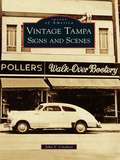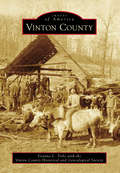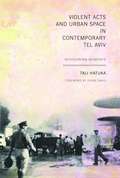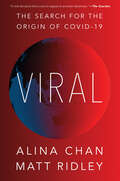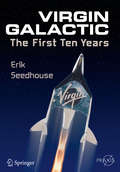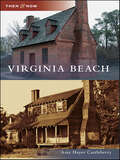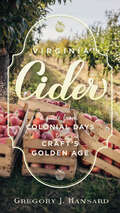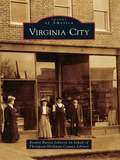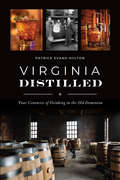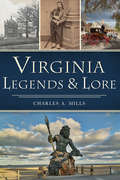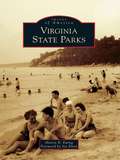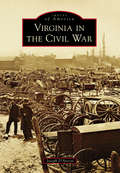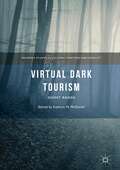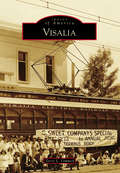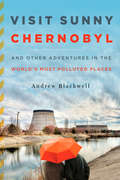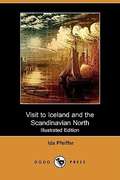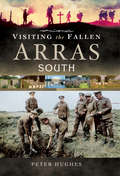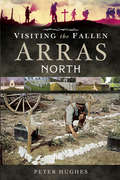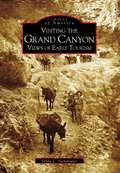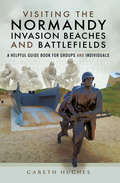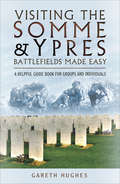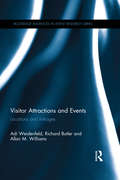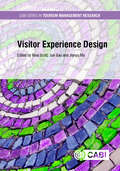- Table View
- List View
Vintage Camper Trailer Rallies
by Paul Lacitinola Caroline LacitinolaA celebration of vintage midcentury trailers and the people that love them. This follow-up to the authors&’ Vintage Camper Trailers focuses on trailer rallies, events where hundreds of vintage trailers aficionados come together to show off their trailers and share their love of the hobby. It features hundreds of new photos of trailerites and their trailers, along with the fun and festivities that occur at the rallies. Also included are a history of camper trailers, along with information on the major trailer hobby groups, such as Tin Can Tourists, the Wally Byam Airstream Club, and Sisters on the Fly, and tips on how to plan and organize your own rallies and events, based on the authors&’ own first-hand experience.
Vintage Tampa Signs and Scenes
by John V. CinchettDuring the 1950s, the Cinchett Neon Sign Company came to be Tampa's best-known sign maker. When the city planned to build a zoo, the mayor asked Cinchett to design the new sign. Fried chicken king Colonel Sanders had the sign company create all the neon work for his first two Kentucky Fried Chicken restaurants in Central Florida, and soon after, other reputable businesses came calling.
Vinton County
by Deanna L. Tribe Vinton County Historical and Genealogical SocietyWhen Ohio became a state in 1803, settlement of what would become Vinton County had hardly begun. Largely forested then and now, Vinton was carved out of the five adjacent counties and in 1850 became the second-to-last county established in Ohio. McArthur, which later became the county seat with a population of 424, was laid out as the village of McArthurstown in 1815; the village celebrates its bicentennial in 2015, having grown to about 1,700 residents. Although rural in manner, life, and outlook, Vinton Countians have maintained a strong sense of community through both good and bad times in this part of Ohio Appalachia. Images of America: Vinton County features images from the Vinton County Historical and Genealogical Society and photograph collections shared by residents. This book presents a snapshot of the county's history, heritage, and culture--a story seldom presented in print.
Violent Acts And Urban Space In Contemporary Tel Aviv
by Tali HatukaViolent acts over the past fifteen years have profoundly altered civil rituals, cultural identity, and the meaning of place in Tel Aviv. Three events in particular have shed light on the global rule of urban space in the struggle for territory, resources, and power: the assassination of Prime Minister Rabin in 1995 in the city council square; the suicidal bombing at the Dolphinarium Discothèque along the shoreline in 2001; and bombings in the Neve Shaanan neighbourhood in 2003. Tali Hatuka uses an interdisciplinary framework of urban theory and socio-political theory to shed light on the discourse regarding violent events to include an analysis of the physical space where these events take place. She exposes the complex relationships among local groups, the state, and the city, challenging the national discourse by offering a fresh interpretation of contesting forces and their effect on the urban environment. Perhaps the most valuable contribution of this book is its critical assessment of the current Israeli reality, which is affected by violent events that continually alter the everyday life of its citizens. Although these events have been widely publicized by the media, there is scant literature focusing on their impact on the urban spaces where people live and meet. In addition, Hatuka shows how socio-political events become crucial defining moments in contemporary lived experience, allowing us to examine universal questions about the way democracy, ideology, and memory are manifested in the city.
Viral: The Search for the Origin of Covid-19
by Matt Ridley Alina Chan"Chan and Ridley write with an urgency...that inspires gripping depictions of what viruses are, how infectious-disease laboratories work and wonderfully lucid descriptions of bats. . . . They powerfully recount how dangerous pathogens can both leak from a lab and emerge in nature." (New York Times Book Review) Understanding how Covid-19 started is crucial for the future of humankind. Viral is the most incisive and authoritative book about the search for the source of the virus.A new virus descended on the human species in 2019 wreaking unprecedented havoc. Finding out where it came from and how it first jumped into people is an urgent priority, but early expectations that this would prove an easy question to answer have been dashed. Nearly two years into the pandemic, the crucial mystery of the origin of SARS-CoV-2 is not only unresolved but has deepened. In this uniquely insightful book, a scientist and a writer join forces to try to get to the bottom of how a virus whose closest relations live in bats in subtropical southern China somehow managed to begin spreading among people more than 1,500 kilometres away in the city of Wuhan. They grapple with the baffling fact that the virus left none of the expected traces that such outbreaks usually create: no infected market animals or wildlife, no chains of early cases in travellers to the city, no smouldering epidemic in a rural area, no rapid adaptation of the virus to its new host—human beings. To try to solve this pressing mystery, Viral delves deep into the events of 2019 leading up to 2021, the details of what went on in animal markets and virology laboratories, the records and data hidden from sight within archived Chinese theses and websites, and the clues that can be coaxed from the very text of the virus’s own genetic code. The result is a gripping detective story that takes the reader deeper and deeper into a metaphorical cave of mystery. One by one the authors explore promising tunnels only to show that they are blind alleys, until, miles beneath the surface, they find themselves tantalisingly close to a shaft that leads to the light.
Virgin Galactic
by Erik SeedhouseThirty years ago when Sir Richard Branson called up Boeing and asked if they had a spare 747, few would have predicted the brash entrepreneur would so radically transform the placid business of air travel. But today, Branson flies airlines on six continents, employs hundreds of jets and, in 2014, was predicting that his spaceship company - Virgin Galactic - would soon open the space frontier to commercial astronauts, payload specialists, scientists and space tourists. With more than 600 seats sold at $250,000 each, what started off as a dream to send people just for the excitement to look back and marvel at Earth, was on the cusp of finally being turned into a business. Then, on October 21, 2014, tragedy struck. SpaceShipTwo was on its most ambitious test flight to date. Seconds after firing its engine, Virgin Galactic's spaceship was breaking through the sound barrier. In just the three seconds that it took for the vehicle to climb from Mach 0. 94 to Mach 1. 02, co-pilot Mike Alsbury made what many close to the event believe was a fatal mistake that led to his death and the disintegration of SpaceShipTwo. Miraculously, the pilot, Peter Siebold, survived the 16-km fall back to Earth. Soon after the event Branson vowed to continue his space tourism venture in spite of this. Already a second SpaceShipTwo is being built, and ticket-holders eagerly await the day when Virgin Galactic offers quick, routine and affordable access to the edge of space. This book explains the hurdles Virgin Galactic had and still has to overcome en route to developing suborbital space travel as a profitable economic entity, and describes the missions that will be flown on board SpaceShipTwo Mk II, including high-altitude science studies, astronomy, life sciences, and microgravity physics.
Virginia Beach
by Amy Hayes CastleberryVirginia Beach offers a variety of attractions, but few who visit know that there is an area with a history that dates back to the 17th century. Many early structures remain intact and appreciated, while others fell into ruin and exist only in photographs and memories. Then & Now: Virginia Beach is a road trip through the past and present.
Virginia Cider: A Guide from Colonial Days to Craft's Golden Age
by Gregory J. HansardYour guide to the remarkable history, and ongoing popularity, of cider in the Commonwealth A cultural phenomenon with surprisingly deep roots, cider has been one of Virginia&’s favorite beverages for more than four hundred years, representing a time-honored ingredient of the cultural heritage that the first English settlers brought with them to America. Since the seventeenth century, apple orchards have been a fixture of the farming landscape, and cider was made and consumed by almost everyone—men, women, and children of all socioeconomic orders throughout the state&’s history. Recent decades have witnessed a renaissance of cider culture and cultivation, and today cider-making is a thriving craft-beverage industry, gaining ever-greater numbers of enthusiasts and connoisseurs as more and more cideries spring up every year. An essential title for the Virginian bookshelf, and for all readers interested in American cider: • The definitive history of making and drinking cider in Virginia • An in-depth guide profiling the cideries throughout the state, from Bold Rock to Big Fish, with &“Try This&” suggestions for each location, and a comprehensive map to help plan excursions • Brief descriptions of the varieties of apples preferred by Virginia&’s cider makers • In-depth overviews of everything from Home Cider Making to Laird & Company to Wassail
Virginia City
by Thompson-Hickman County LibraryTucked between the Tobacco Root Mountains and Mount Baldy in southwestern Montana, Virginia City began in May 1863, when gold was discovered in Alder Gulch. Some 10,000 fortune seekers arrived, and the days of whiskey, revolvers, road agents, and vigilantes began. Boot Hill, overlooking the town, is a constant reminder of its rough, tough, and unruly past. A great number of mining towns have become ghost towns, but not Virginia City, thanks to the men and women who gave of themselves to establish a permanent town where families, schools, churches, businesses, and organizations would thrive.
Virginia Distilled: Four Centuries of Drinking in the Old Dominion (American Palate)
by Patrick Evans-HyltonColonist George Thorpe first crafted "corn beere," an ancestor to bourbon, in 1620 at Berkeley Plantation, and George Washington once operated one of the nation's largest distilleries. Icy mint juleps were first served in Virginia until the state was one of the first to enact Prohibition. That dark period gave rise to bootlegging, moonshining and even NASCAR. Through well-documented research, interviews with key stakeholders and plenty of cocktail recipes for the reader to shake and stir at home, author Patrick Evans-Hylton showcases the rich history of four hundred years of drinking in the Commonwealth. Raise a glass to Virginia, birthplace of American spirits, and its long history of distilling and imbibing.
Virginia Legends & Lore (American Legends)
by Charles A. MillsFor centuries, Virginians have told, retold and embellished wonderful stories of their history. Legends such as the "wild Spanish ponies" of Chincoteague, General Braddock's lost gold, the Mount Vernon Monster and the Richmond Vampire tug at the imagination. Revolutionary War heroes, Annandale's Bunny Man, the enslaved woman who became a Union spy in the White House of the Confederacy and many others left imprints on the Commonwealth of Virginia. Explore secret societies, hidden knowledge and the mysteries of the universe with author Chuck Mills.
Virginia State Parks
by Joe Elton Sharon B. EwingPres. Franklin Roosevelt's establishment of the Civilian Conservation Corps in 1933 had lasting conservation impacts across the nation. Virginia joined this effort when Will Carson of the Virginia Conservation Commission convinced Roosevelt to use the Civilian Conservation Corps to build a state park system. Virginia is distinguished as the only state in the nation to open a system of state parks on one day. On June 15, 1936, the first six state parks--Douthat, Seashore (present day First Landing), Hungry Mother, Fairy Stone, Westmoreland, and Staunton River State Parks--were opened. From these humble beginnings, the commonwealth has developed over 35 diverse, award-winning state parks. From seashore to mountains, take a journey across Virginia through a vast array of landscapes and unrivaled natural and cultural resources.
Virginia in the Civil War (Images of America)
by Joseph D'ArezzoNo other event in American history has so indelibly shaped the country than the American Civil War. Virginia provided the setting for countless bloody clashes and decisive battles. Average Americans from all over the Union and the Confederacy made their way to the Old Dominion, only to give their lives for the causes they held dear. Virginia captures the essence of the American Civil War, as it was the site of the first, and last, major clash. The state held the capital of the Confederacy while simultaneously bordering Washington, DC. Additionally, Virginia was the site of infamous battles, such as Manassas, Fredericksburg, and Chancellorsville. The commonwealth was also the location of Gen. Robert E. Lee's dramatic capitulation to Gen. Ulysses S. Grant at Appomattox. The American Civil War was one of the first armed conflicts to be heavily documented through photographs. In recent years, the Library of Congress has compiled many of these images, helping to make this journey through history possible.
Virtual Dark Tourism: Ghost Roads (Palgrave Studies In Cultural Heritage And Conflict )
by Kathryn N. McDanielThis book takes the concept of “dark tourism”—journeys to sites of death, suffering, and calamity—in an innovative yet essential direction by applying it to the virtual realms of literature, film and television, the Internet, and gaming. Essays focus both on the creative construction of imaginary journeys and the historiographic and civic consequences of such memorializations. From World War II time-travel novels to Game of Thrones, and from Internet reproductions of Rwandan genocide locations to invented tragedies in futuristic domains, authors from various fields examine the purpose and influence of simulated travels to morbid sites. Designed for a wide audience of scholars and travelers virtual and real, this volume raises awareness about the many pathways through which we encounter death experiences in contemporary society. What we know about the past—or, what we think we know about it—is shaped daily by such imagined journeys as these.
Visalia (Images of America)
by Terry L. OmmenWhen the first settlers arrived in what is now Visalia in the fall of 1852, they found a lush river delta in the midst of an oak forest at the base of the Sierra Nevada. The soil was fertile, just right for farming, enabling Visalia to take root as the oldest town in the southern San Joaquin Valley. For the next 163 years, the town provided important products and services, like David Walker's Saddle Shop that became home to the famous Visalia Stock Saddle and Ben Maddox's Mount Whitney Power Company that harnessed water from the Kaweah River for electricity. Now with a population of almost 130,000, the county seat of Tulare County continues to be surrounded by some of the most productive farmland in the world and is a vibrant business center.
Visit Sunny Chernobyl: And Other Adventures in the World's Most Polluted Places
by Andew BlackwellFor most of us, traveling means visiting the most beautiful places on Earth—Paris, the Taj Mahal, the Grand Canyon. It's rare to book a plane ticket to visit the lifeless moonscape of Canada's oil sand strip mines, or to seek out the Chinese city of Linfen, legendary as the most polluted in the world. But in Visit Sunny Chernobyl, Andrew Blackwell embraces a different kind of travel, taking a jaunt through the most gruesomely polluted places on Earth. From the hidden bars and convenience stores of a radioactive wilderness to the sacred but reeking waters of India, Visit Sunny Chernobyl fuses immersive first-person reporting with satire and analysis, making the case that it's time to start appreciating our planet as it is—not as we wish it would be. Irreverent and reflective, the book is a love letter to our biosphere's most tainted, most degraded ecosystems, and a measured consideration of what they mean for us. Equal parts travelogue, expose, environmental memoir, and faux guidebook, Blackwell careens through a rogue's gallery of environmental disaster areas in search of the worst the world has to offer—and approaches a deeper understanding of what's really happening to our planet in the process.
Visit to Iceland and the Scandinavian North
by Ida PfeifferA besetting sin of the Icelanders is their drunkenness. Their poverty would probably not be so great if they were less devoted to brandy, and worked more industriously. <P> <P> It is dreadful to see what deep root this vice has taken. Not only on Sundays, but also on week-days, I met peasants who were so intoxicated that I was surprised how they could keep in their saddle. I am, however, happy to say that I never saw a woman in this degrading condition.
Visiting the Fallen: Arras South
by Peter HughesThis companion volume to Visiting the Fallen: Arras North provides in-depth information of the WWI battlefield, its significance, and its cemeteries.Arras, France, was a frontline town throughout the Great War. In 1916, it became home to the British Army and it remained so until the Advance to Victory. The area around Arras is as rich in Commonwealth War Graves Commission cemeteries as anywhere on the Western Front, yet they remain largely unvisited. This book explores those cemeteries, and tells the story of the men who are buried there.Visiting the Front: Arras-South contains comprehensive coverage of over 60 Commonwealth War Graves Commission cemeteries to be found in Arras and to the south of the town. It has a wealth of gallantry awards, including their citations, and features hundreds of officers and other ranks who fell during the war. Many small actions, raids and operations are described in a book that tells the story of warfare on the Western Front through the lives of those who fought and died on the battlefields of Arras. This is an essential reference guide for anyone visiting Arras and its battlefields.
Visiting the Fallen: Arras: North
by Peter HughesLike Ypres, Arras was a front line town throughout the Great War. From March 1916 it became home to the British Army and it remained so until the Advance to Victory was well under way. In 1917 the Battle of Arras came and went. It occupied barely half a season, but was then largely forgotten; the periods before and after it have been virtually ignored, and yet the Arras sector was always important and holding it was never easy or without incident; death, of course, was never far away. The area around Arras is as rich in Commonwealth War Graves Commission cemeteries as anywhere else on the Western Front, including the Somme and Ypres, and yet these quiet redoubts with their headstones proudly on parade still remain largely unvisited. This book is the story of the men who fell and who are now buried in those cemeteries; and the telling of their story is the telling of what it was like to be a soldier on the Western Front. 'Arras-North' is the first of three books by the same author. This volume contains in depth coverage of almost sixty Commonwealth War Graves Commission cemeteries and is a veritable 'Who's Who' of officers and other ranks who fell on this part of the Western Front. It provides comprehensive details of gallantry awards and citations and describes many minor operations, raids and other actions, as well as the events that took place in April and May 1917. It is the story of warfare on the Western Front as illustrated through the lives of those who fought and died on the battlefields of Arras.There are many unsung heroes and personal tragedies, including a young man who went out into no man's land to rescue his brother, an uncle and nephew killed by the same shell, a suicide in the trenches and a young soldier killed by a random shell whilst celebrating his birthday with his comrades. There is an unexpected connection to Ulster dating back to the days of Oliver Cromwell and William of Orange, a link to Sinn Fein and an assassination, a descendant of Sir Isaac Newton, as well as a conjuror, a friend of P.G. Wodehouse, a young officer said to have been 'thrilled' to lead his platoon into the trenches for the first time, only to be killed three hours later, and a man whose headstone still awaits the addition of his Military Medal after almost a century, despite having been involved in one of the most daring rescues of the war. This is a superb reference guide for anyone visiting Arras and its battlefields.
Visiting the Grand Canyon: Early Views of Tourism
by Linda L. StampoulosThe Colorado River began carving a course to create the Grand Canyon some four to six million years ago, but organized tourism to the natural wonder is fairly young, geologically speaking. Getting to the view along and below the rim has not always been as convenient as packing up the family car and hitting the road. The El Tovar Hotel, celebrating its centennial in 2005, had just opened to lodgers when the Canyon was declared a National Monument in 1908. Between the 1890s and the 1920s, horses, mules, river rafts, stagecoaches, and later railroads and automobiles permitted increasing access to the area. Recreation areas, businesses catering to tourists, and federal preservation programs would eventually mark the Grand Canyon as the ultimate American travel destination.
Visiting the Normandy Invasion Beaches and Battlefields: A Helpful Guide Book for Groups and Individuals
by Gareth HughesThis informative and easy to use WWII travel guide features everything you need to know while exploring the historic sites of D-Day.Whether planning a school tour or a family holiday, this guide provides everything you need to get the most out of your visit. It includes essential historical context to help everyone appreciate the importance of D-Day beaches and battlefields, as well as important information on WWII museums, monuments, and cemeteries.Author and expert tour guide Gareth Hughes provides handy itineraries covering the best places in the Normandy area. A comprehensive overview of each site includes essential facts, visitor orientation, suggested activities, relevant photos and maps. There are also valuable tips for lunch breaks, free time ideas and other helpful pointers.
Visiting the Somme & Ypres Battlefields Made Easy: A Helpful Guide Book for Groups and Individuals
by Gareth HughesVisit the battlefields of the Great War with this easy-to-use planning guide to historic sites in France and Belgium. This splendid and timely book will be invaluable to those visiting the battlefields, sites, museums, memorials and cemeteries of France and Belgium. It is intended for those planning and leading school groups and similar parties but is also ideal for individual and families. Rather than list every site, the book provides realistic itineraries to the best places in the two major areas of the Somme and Ypres. Even these are flexible to allow party leaders suitable discretion.The author provides helpful information for each site such as its context in the War, visitor orientation, the 'spiel' (the essential facts to engage, inform and entertain), suggested activity and relevant photos and maps. There are also valuable tips for lunch breaks, free time ideas and other helpful pointers to make planning a tour easy and enjoyable.
Visitor Attractions and Events: Locations and linkages (Routledge Advances in Event Research Series)
by Allan M. Williams Richard Butler Adi WeidenfeldBoth visitor attractions and events play pivotal roles in the appeal of tourism destination regions to visitors by virtue of being the main motivator of tourist trips and determining consumers’ choices. However, more recently visitor attractions have become more multifaceted, have proliferated and fragmented in terms of form, location, scale and style, and their role is undergoing major changes in a post-modern world as a result of consumer demands and competitive innovations. Visitor Attractions and Events for the first time theoretically and empirically explores the relations between events and attractions to offer new thinking of the role of space and place in shaping development, management practices and strategies in the sector as well as future implications. The book reveals how location is pivotal in the development, planning, and management of visitor attractions and events. Whereas the location of natural attractions is relatively fixed in space and their locations cannot be predetermined or relocated, human-made or contrived attractions are more influenced by the planning process in the context of the locational decision-making process. Competition and cooperation between visitor attractions and the aspects which shape these relations, including complementarities, compatibility, knowledge spill overs and diffusion of innovations, product similarities and spatial proximity remain largely ignored in the visitor attraction sector and thus are major elements in the focus of this book. Comparative examples ranging from small to major attractions in a wide variety of locations are included. This significant volume will appeal widely to all those interested in the visitor sector, such as tourism, events, leisure studies, destination management and sociology.
Visitor Experience Design
by Noel Scott Jun Gao Jianyu MaMost discussion of visitor experiences uses a behavioural or managerial approach where the way the visitor thinks is ignored - it's a black box. Visitor Experience Design is the first book of its kind to examine best practice in creating and delivering exciting and memorable travel and visitation experiences from a cognitive psychological perspective - it opens the black box. The chapters draw on recent findings from cognitive psychology, cognitive science and neuroscience to provide a basis for a better understanding of the antecedents of a memorable experience, including: #65533; The psychological process of the formation or creation of a visitor's experiences #65533; Psychological aspects of tourism experiences such as attention, emotion, memory and mindfulness #65533; Pre-stage experience: customer inputs such as knowledge, myths, values and memories from previous travel #65533; On-site experience: co-creation processes #65533; Post-stage experience: immediate and long term outcomes including happiness and well-being #65533; Experience design cases Tourism, hospitality and event managers seek to provide WOW experiences to their visitors through better design and management. This book encourages the discussion of different facets of experience design such as emotions, attentions, sensations, learning, the process of co-creation and experiential stimuli design. It will be of interest to tourism researchers and postgraduate students studying tourism management, marketing and product design.
Visitor Experience Design (Cabi Series In Tourism Management Research Ser.)
by Pierre Benckendorff Wei Liu Xiang Li Ying Wang Dr Júlio Mendes Ana Claudia Campos I-Ling Chen Peiyi Ding Rouven Doran Afiya Holder Shan Jiang Svein Larsen Dung Le Kuan-Huei Lee Shanshi Li Brent Moyle Liubov Skavronskaya Beverley Sparks Patricia Valle Gabby Walters Katharina Wolff Laurie Wu Lihua GaoMost discussion of visitor experiences uses a behavioural or managerial approach where the way the visitor thinks is ignored - it's a black box. Visitor Experience Design is the first book of its kind to examine best practice in creating and delivering exciting and memorable travel and visitation experiences from a cognitive psychological perspective - it opens the black box. The chapters draw on recent findings from cognitive psychology, cognitive science and neuroscience to provide a basis for a better understanding of the antecedents of a memorable experience, including: · The psychological process of the formation or creation of a visitor's experiences · Psychological aspects of tourism experiences such as attention, emotion, memory and mindfulness · Pre-stage experience: customer inputs such as knowledge, myths, values and memories from previous travel · On-site experience: co-creation processes · Post-stage experience: immediate and long term outcomes including happiness and well-being · Experience design cases Tourism, hospitality and event managers seek to provide WOW experiences to their visitors through better design and management.This book encourages the discussion of different facets of experience design such as emotions, attentions, sensations, learning, the process of co-creation and experiential stimuli design. It will be of interest to tourism researchers and postgraduate students studying tourism management, marketing and product design.

